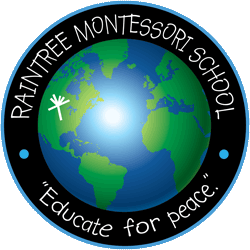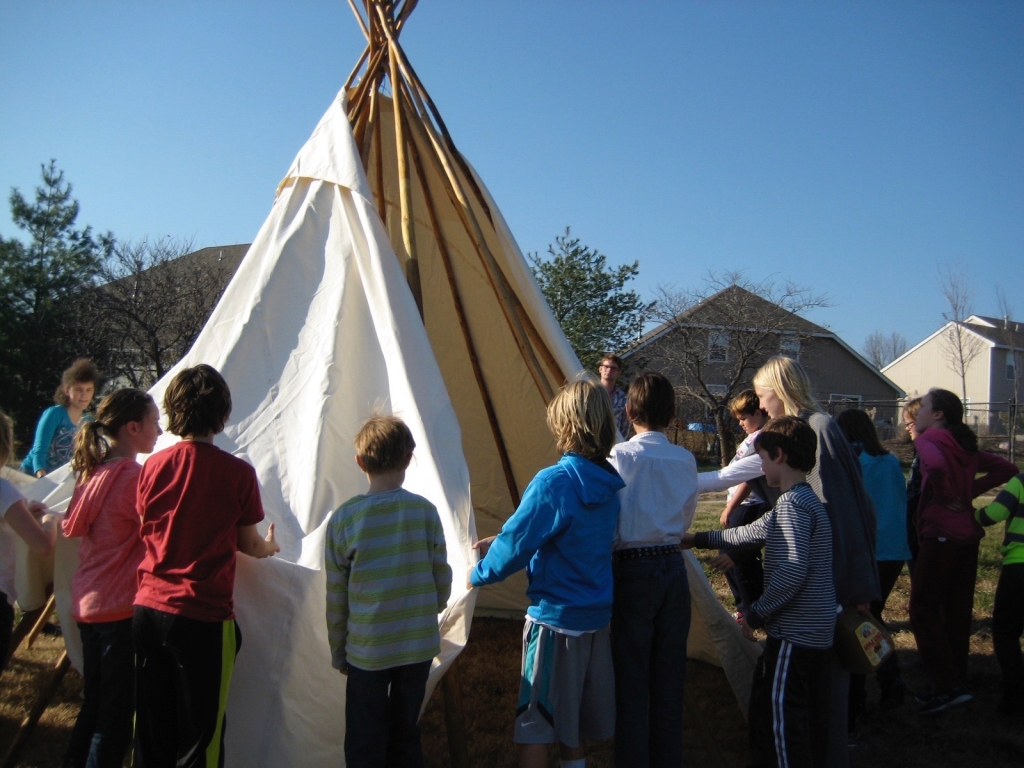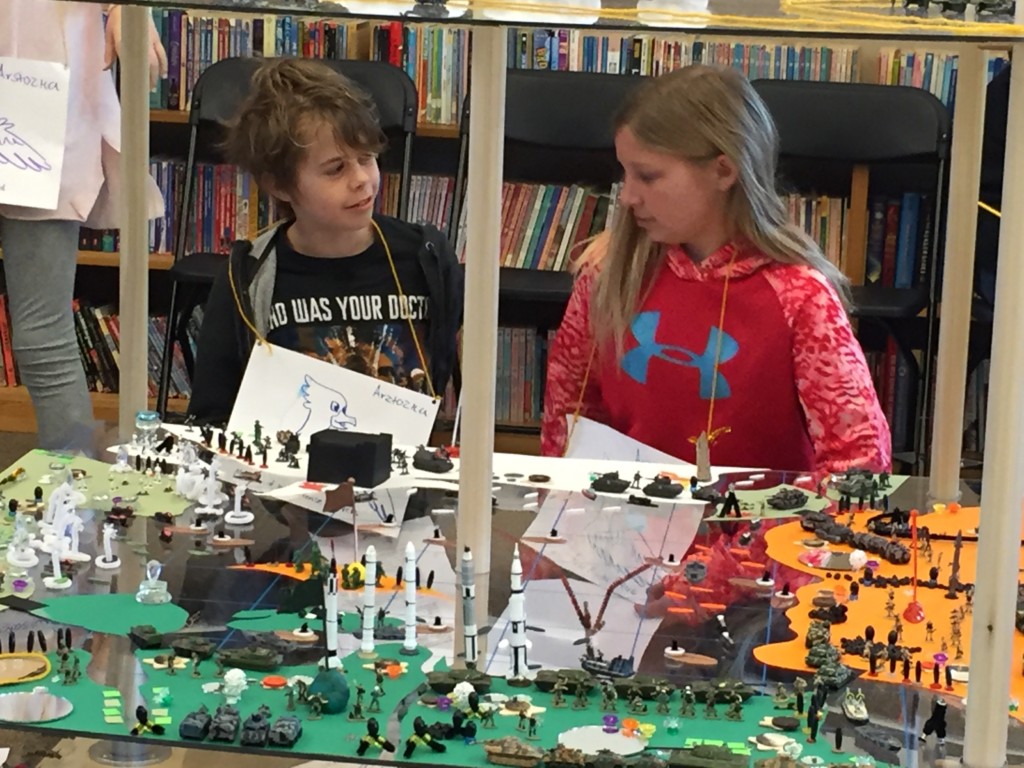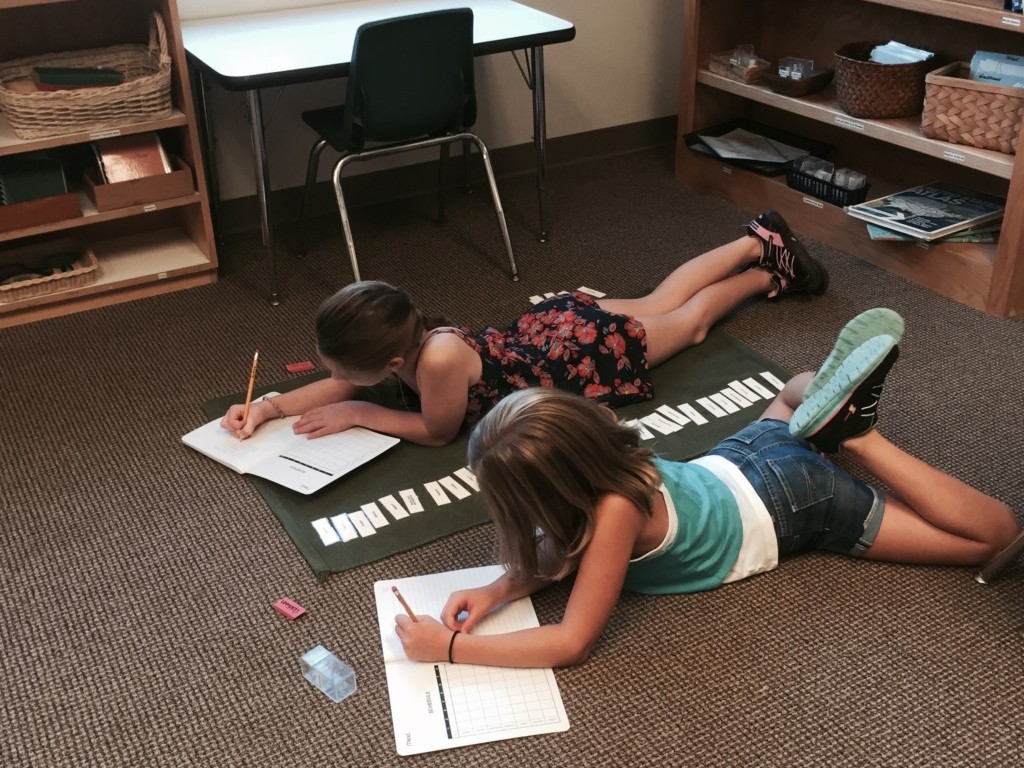A day in the life of a Raintree elementary student
Some students arrive early (7:30-8:15 AM). These early arrivers congregate on the playground where equipment is set up for their use. Early morning is also a perfect time to jog on the pathway or just visit with friends. In the winter, if it is too cold, students gather in the library.
At 8:15 the students go to their classrooms where they put away their personal belongings and join others who arrive at 8:15 to socialize before class begins. Socializing is important. Tat is why there is no charge for this 15-minute period. Arriving on time, or even a few minutes early, is an important life lesson and something that will serve the child well throughout her life.
At 8:30, the teacher begins morning announcements. Some days there are no announcements, and the teacher calls the frst group to her table for a lesson. Some students begin the day in a lesson while others prepare a snack and read the newspaper before starting their work. Some students work individually while others begin their day working on a group project with others. Teir work plan or work diary helps guide them in their choices throughout the day. A buzz of activity flls the classroom as the three-hour uninterrupted work cycle unfolds.
About that buzz…
A lower elementary class is noisier and messier than an upper elementary class because the younger students are developing social skills. Most of the work they do is with concrete hands-on materials requiring movement. Upper elementary classes, in general, are quieter because they are refining their social skills and gradually giving up the concrete materials and moving into abstraction. Lower elementary is characterized by movement and noisier collaboration while upper elementary students are involved in pencil and paper tasks. Montessori’s “Planes of Development” diagram illustrates this phenomenon, something she observed in children all over the world, in every socio-economic strata, in every classroom. The first sub-plane of the six-year cycle is one of intense activity while the second sub-plane is a time for refining concepts and is calmer, one for refection.
During the three-hour work cycle, students record their work in a diary or check off tasks in a work plan. The ebb and flow of classroom life varies from day to day, The students have access to the library located in the Phoenix building, the staff in the classroom who act as guides and the campus to further their lessons.
At the end of the cycle, the lower elementary students complete their diary or plan, recording the last bit of work accomplished for the morning. The students who are responsible setting up the lunch buffet, while the rest of the class clean their tables and put away their work. In the lower elementary students prepare for lunch, but in the upper elementary, students go outside for a 45-minute recess followed by lunch. The recess time is staggered with the upper elementary going outside first followed by the lower elementary 45 minutes later. Once the lower elementary students finish lunch and clean up the classroom, they go outside for their 45-minute recess.
In the interim between lunch and outside time, the students who are not involved in jobs get out a book for silent reading. Studies have shown that uninterrupted sustained silent reading is one of the best ways to develop good reading skills. In the afternoon, another two-hour uninterrupted work cycle begins with the same procedure as the morning.
Once a week during the day…
- The students conference with the teacher. All the week’s work is brought to the teacher along with the student’s work diary or plan. A number of strategies are used to guide the student in his work. A notebook with the goals and objectives of the public school at each grade level is sometimes used to show the student what the expectations would be if he were in a traditional classroom. Most often the notebook serves as a baseline. Occasionally a student will require more frequent conferencing, especially if the student is new, or has been in a 59 ELEMENTARY DAY traditional classroom. Te conference is a time to evaluate the students work choices, the quality and quantity of their work and the goals for the coming week.
Once a week in the afternoon…
- The lower elementary students participate in Orff music in small groups, while the upper elementary students go to choral music.
- The class has a meeting to discuss issues which involve the immediate classroom community, but may also involve all school, campus, city or global issues as well.
- Students have an opportunity to present a finished work to the class. Presentations are an outgrowth of lessons and may include anything from a math presentation to producing a play. Sometimes students present a group research project to the class.
The elementary child differs considerably from the primary child. The 3-6-year-old child is an egocentric sensorial explorer, touching, tasting, feeling the environment concerned with the here and now and questions of what and where, but the elementary child is a social being, interested in doing what Montessori called the “great work” intrigued by questions of why and how and equipped with an imagination to continue the journey of constructing himself. What are his noble pursuits? Solving giant math problems, writing plays and performing them, doing science experiments and presenting them to the class or drawing plans to build something…and then building it.
The concrete materials at the end of the sequences in each area of the Children’s House form the beginning of the sequences in the areas in the elementary so there is no interruption in the work of the child. Everything is integrated. The same beads which illustrated units, tens, hundreds and thousands and everything are found in the math area of the elementary. At the lower elementary level, students continue concrete work and move gradually toward abstraction. Lessons are given in small seminar groups by the Guide, and children also learn from one another. Collaboration among students is encouraged.
Students record their work in a diary and meet with the guide for a conference weekly bring their finished and unfinished work to the meeting. From this discussion the student formulates a plan for the completion of work and asks for lessons in specific areas. The guide offers help and guidance for future work choices.
Presentation days are scheduled weekly. Students who have completed a project, written a play, poem or story, prepared a culinary masterpiece, painted a painting, solved a difficult math problem, or done an interesting science experiment present their work to their peers. The only stipulation is that they must have gone through one critique before presenting their work to the class. Students learn how to refine their finished products, and the other students who attend the presentation learn how to be a good audience.
Weekly class meetings provide a forum for discussion about a variety of topics from issues involving the class to concerns in the local community to problems facing the planet. Students learn how to problem solve, take on causes and get along with one another.
“Going out” is unique to Montessori elementary programs and refers to going beyond the four walls of the classroom to learn. When a child or a group of children has exhausted the resources in the classroom, she visits an expert, or goes to another library or museum to find out more. The student makes an appointment with the expert or the director of the library or museum, gets a map of the city, figures out the best way to get to the destination, calls from a list of approved drivers, formulates the questions to be answered, takes a tape recorder, and travels the destination instructing the driver where to go. Once the interview is completed, the student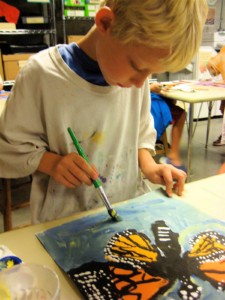 writes a thank you note to the driver and the expert. The easy course would be to hook the student up to the internet and let her surf for the afternoon, but think how much the student will miss out on…map skills, communication skills, writing skills, listening skills, grace and courtesy skills, just to mention a few.
writes a thank you note to the driver and the expert. The easy course would be to hook the student up to the internet and let her surf for the afternoon, but think how much the student will miss out on…map skills, communication skills, writing skills, listening skills, grace and courtesy skills, just to mention a few.
All the subjects are integrated in an elementary classroom. A visit to an elementary classroom at Raintree will find children composing music on the tone bars, painting with watercolors, practicing the violin, solving square root problems with concrete materials, classifying plants in the garden, and diagramming sentences. There is an emphasis on open-ended research, and there are no Montessori textbooks. Montessori said, “Don’t show children pictures of flowers. Go to the garden and grow real flowers.”
